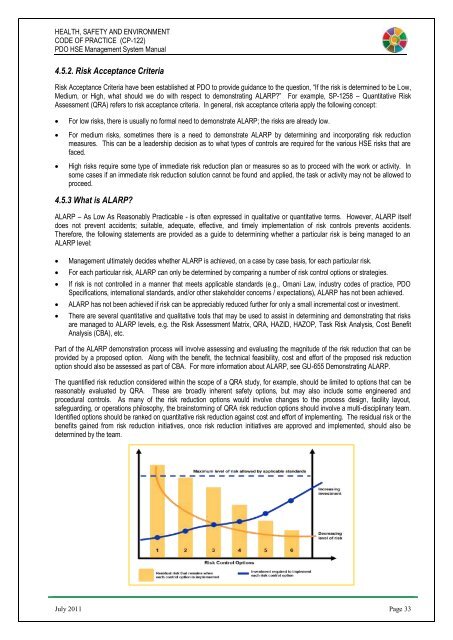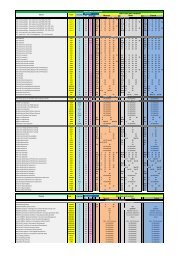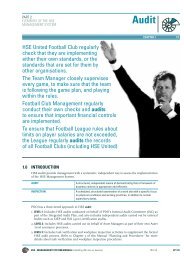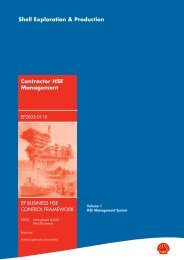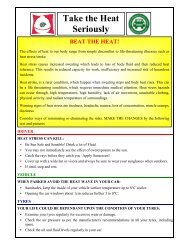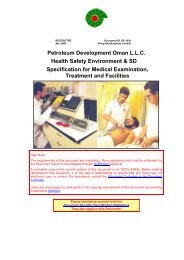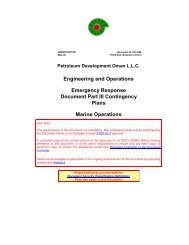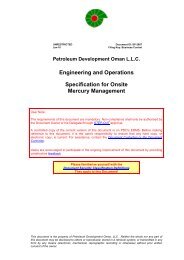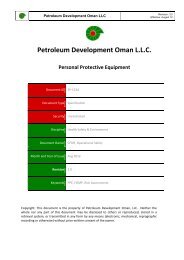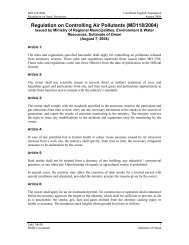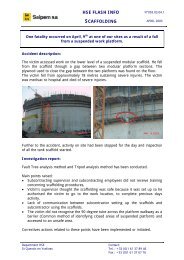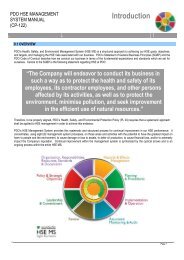CP-122 HSE Code of Practice - PDO
CP-122 HSE Code of Practice - PDO
CP-122 HSE Code of Practice - PDO
You also want an ePaper? Increase the reach of your titles
YUMPU automatically turns print PDFs into web optimized ePapers that Google loves.
HEALTH, SAFETY AND ENVIRONMENT<br />
CODE OF PRACTICE (<strong>CP</strong>-<strong>122</strong>)<br />
<strong>PDO</strong> <strong>HSE</strong> Management System Manual<br />
4.5.2. Risk Acceptance Criteria<br />
Risk Acceptance Criteria have been established at <strong>PDO</strong> to provide guidance to the question, “If the risk is determined to be Low,<br />
Medium, or High, what should we do with respect to demonstrating ALARP?” For example, SP-1258 – Quantitative Risk<br />
Assessment (QRA) refers to risk acceptance criteria. In general, risk acceptance criteria apply the following concept:<br />
<br />
<br />
<br />
For low risks, there is usually no formal need to demonstrate ALARP; the risks are already low.<br />
For medium risks, sometimes there is a need to demonstrate ALARP by determining and incorporating risk reduction<br />
measures. This can be a leadership decision as to what types <strong>of</strong> controls are required for the various <strong>HSE</strong> risks that are<br />
faced.<br />
High risks require some type <strong>of</strong> immediate risk reduction plan or measures so as to proceed with the work or activity. In<br />
some cases if an immediate risk reduction solution cannot be found and applied, the task or activity may not be allowed to<br />
proceed.<br />
4.5.3 What is ALARP?<br />
ALARP – As Low As Reasonably Practicable - is <strong>of</strong>ten expressed in qualitative or quantitative terms. However, ALARP itself<br />
does not prevent accidents; suitable, adequate, effective, and timely implementation <strong>of</strong> risk controls prevents accidents.<br />
Therefore, the following statements are provided as a guide to determining whether a particular risk is being managed to an<br />
ALARP level:<br />
<br />
<br />
<br />
<br />
<br />
Management ultimately decides whether ALARP is achieved, on a case by case basis, for each particular risk.<br />
For each particular risk, ALARP can only be determined by comparing a number <strong>of</strong> risk control options or strategies.<br />
If risk is not controlled in a manner that meets applicable standards (e.g., Omani Law, industry codes <strong>of</strong> practice, <strong>PDO</strong><br />
Specifications, international standards, and/or other stakeholder concerns / expectations), ALARP has not been achieved.<br />
ALARP has not been achieved if risk can be appreciably reduced further for only a small incremental cost or investment.<br />
There are several quantitative and qualitative tools that may be used to assist in determining and demonstrating that risks<br />
are managed to ALARP levels, e.g. the Risk Assessment Matrix, QRA, HAZID, HAZOP, Task Risk Analysis, Cost Benefit<br />
Analysis (CBA), etc.<br />
Part <strong>of</strong> the ALARP demonstration process will involve assessing and evaluating the magnitude <strong>of</strong> the risk reduction that can be<br />
provided by a proposed option. Along with the benefit, the technical feasibility, cost and effort <strong>of</strong> the proposed risk reduction<br />
option should also be assessed as part <strong>of</strong> CBA. For more information about ALARP, see GU-655 Demonstrating ALARP.<br />
The quantified risk reduction considered within the scope <strong>of</strong> a QRA study, for example, should be limited to options that can be<br />
reasonably evaluated by QRA. These are broadly inherent safety options, but may also include some engineered and<br />
procedural controls. As many <strong>of</strong> the risk reduction options would involve changes to the process design, facility layout,<br />
safeguarding, or operations philosophy, the brainstorming <strong>of</strong> QRA risk reduction options should involve a multi-disciplinary team.<br />
Identified options should be ranked on quantitative risk reduction against cost and effort <strong>of</strong> implementing. The residual risk or the<br />
benefits gained from risk reduction initiatives, once risk reduction initiatives are approved and implemented, should also be<br />
determined by the team.<br />
July 2011 Page 33


